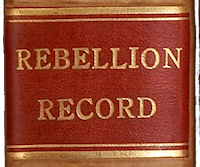November 19.—Some men of Capt Hill’s Cavalry had a skirmish near Wirt Court House, Western Virginia, with a gang of rebels calling themselves the Moccasin Rangers. There was a corn-husking at the house of a secessionist, about a mile from Wirt Court House, and some of Capt. Hill’s men obtained leave of absence and attended the affair without arms. After the men had started, the balance of the company were advised that their companions were to be attacked and captured at the husking, by the Moccasin Rangers. Accordingly the company armed themselves, and proceeded as quietly as possible down to the husking. They had scarcely reached the house and formed themselves in position, when the Moccasin Rangers made a charge upon the house. Capt. Hill’s men fired upon the Moccasins before the latter were aware of their presence in force, killing a lieutenant and wounding five or six others. The rangers retreated.
—The rebel steamer Nashville, Capt. Pegram, captured, in the British channel, the American ship Harvey Birch, bound from Havre to New York, in ballast, the captain and crew of which were taken off, and the vessel burnt to the water’s edge. The Nashville then ran into Southampton, England, landed the prisoners, and remained there.—(Doc. 182.)
—Isham G. Harris, Governor of Tennessee, called out the militia of the Second, Third, and Fourth Divisions of that State to be ready to march by the 25th, “unless, in the mean time, a sufficient number of volunteers shall have tendered their services to fill” the requisition made upon him by General A. S. Johnson of the Confederate States Army.—(Doc. 177.)
—Warsaw, the capital of Benton County, Missouri, was burned. The flames broke out at six P. M., and all the business portion of the town was laid in ashes.
—G. Wallace Ewer, son of Captain John Ewer, of New Bedford, Massachusetts, was promoted from a Master’s Mate to Acting Master, for gallant conduct at the Port Royal fight. He served on board the Mohican. His father was in the same action on board the Sabine.
—Major-General H. W. Halleck, U. S. A., assumed command of the department of the Missouri, Major-General Hunter having been assigned to the Department of Kansas. Gen. Halleck issued an order establishing his headquarters at St. Louis.
—This morning, about ten o’clock, Company A, of the First Delaware regiment, left Camp Hamilton, near Fortress Monroe, on a scouting expedition. The corps was under command of Captain Watson, of Wilmington. They crossed Hampton Creek, and when about one and a half miles beyond the outer pickets encountered a considerable body of rebel cavalry, who were accompanied by two field-howitzers, brass rifled pieces, and the first intimation the Delawarians had of the enemy’s position on near approach, was the whistling of a projectile through the woods and underbrush. Captain Watson then threw up a temporary defence of brushwood and earth, after advancing to an eligible position, and sent back for reinforcements.
General Mansfield, accompanied by three companies of the New York Twentieth, Col. Max Weber, proceeded to the relief of the Delaware troops.
—A Flag of truce from Norfolk to-day brought to Fortress Monroe, Va., Lieut. Worden, U. S. N., who was taken prisoner while bearing despatches to Fort Pickens at the breaking out of hostilities, and imprisoned at Montgomery, Alabama, for some time. He was exchanged for Lieut. Short, of the rebel army, who was taken at Hatteras Inlet, and had been confined on the frigate Congress at Newport News.—National Intelligencer, Nov. 21.
—The United States gunboat Penobscot, built at Belfast, Me., by Messrs. C. P. Carter and Co., was launched to-day.—Baltimore American, November 21.
—A Message from Jefferson Davis, President of the “Confederate States,” was received by the rebel Congress in session at Richmond. —(Doc. 178.)
—The U. S. gunboat Conestoga, on a reconnoitring expedition up the Tennessee River, from Paducah, Ky., to-day, discovered a rebel battery near the Tennessee line, and threw shell, routing the enemy from their guns. Still further up another battery was discovered, and an engagement followed, in which the rebels were driven off and a number killed. The Conestoga was but slightly damaged.



